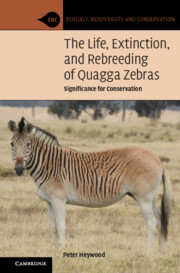Book contents
- The Life, Extinction, and Rebreeding of Quagga Zebras
- Ecology, Biodiversity and Conservation
- The Life, Extinction, and Rebreeding of Quagga Zebras
- Copyright page
- Dedication
- Contents
- Acknowledgments
- Introduction
- 1 Zebras
- 2 Quaggas
- 3 Coat Coloration
- 4 Quaggas, Zebras, and Humans in Southern Africa
- 5 Quaggas Abroad
- 6 Extinction
- 7 Afterlife
- 8 Rebreeding
- 9 Identity and Conservation
- Book part
- Notes
- Bibliography
- Index
8 - Rebreeding
Published online by Cambridge University Press: 30 April 2022
- The Life, Extinction, and Rebreeding of Quagga Zebras
- Ecology, Biodiversity and Conservation
- The Life, Extinction, and Rebreeding of Quagga Zebras
- Copyright page
- Dedication
- Contents
- Acknowledgments
- Introduction
- 1 Zebras
- 2 Quaggas
- 3 Coat Coloration
- 4 Quaggas, Zebras, and Humans in Southern Africa
- 5 Quaggas Abroad
- 6 Extinction
- 7 Afterlife
- 8 Rebreeding
- 9 Identity and Conservation
- Book part
- Notes
- Bibliography
- Index
Summary
Reinhold Rau of the South Africa Museum in Cape Town felt a moral duty to rebreed quaggas. Sequencing showed that mitochondrial DNA from quaggas was identical, or almost so, with corresponding sequences from plains zebras. This conclusion provided the rationale for rebreeding but wildlife officials refused funding. Instead, supported by many people and organizations, Rau and others initiated the Quagga Project which selected offspring from a founder population of nineteen plains zebras with brown coloration of their bodies and relatively few stripes on their legs and hindquarters. By the fourth and fifth generation, animals with coat coloration resembling that of quaggas have been selectively bred, and those with the best coat coloration are named “Rau Quaggas.” Rau Quaggas and other Quagga Project zebras are present in national parks, on private land, and as the Core Herd of the Quagga Project at four locations. Rebreeding of quaggas is compared with other de-extinction projects such as the Giant Tortoise Restoration Initiative that aims to rebreed an extinct species of Galapagos tortoise whose genes are present in an extant tortoise population.
- Type
- Chapter
- Information
- The Life, Extinction, and Rebreeding of Quagga ZebrasSignificance for Conservation, pp. 126 - 146Publisher: Cambridge University PressPrint publication year: 2022

